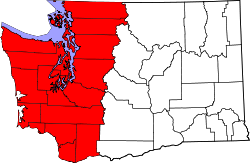Western Washington | |
|---|---|
Region | |
|
Left-right from top: Seattle skyline, Washington State Capitol, WSF MV Wenatchee, Mount Rainier, Diablo Lake, Mount Shuksan, Bellevue skyline | |
 | |
| Coordinates: 48°N 122°W / 48°N 122°W | |
| Country | United States |
| State | Washington |
| Area | |
| • Land | 24,742 sq mi (64,080 km2) |
| Population (2020) | |
| • Total | 6,037,688 |
Western Washington is a region of the United States defined as the area of Washington state west of the Cascade Mountains. This region is home to the state's largest city, Seattle, the state capital, Olympia, and most of the state's residents. The climate is generally far more damp and temperate than that of Eastern Washington.
YouTube Encyclopedic
-
1/5Views:44 52870815 4371 6681 228
-
Western Washington University Campus Tour
-
Fall 2023 Convocation
-
First Morels of the 2022 Season!! Finding them in Western Washington.
-
College of Humanities and Social Sciences – Ceremony 3: Sunday, June 11, 2023 at 4 pm
-
Explore Western Washington University | Go Northwest of Ordinary
Transcription
Climate

Western Washington is known as having a far wetter climate than the eastern portion of the state, primarily due to the effects of the Cascades' rain shadow. The average location in Eastern Washington only receives an average of 46.87 centimeters (18.45 inches) of precipitation per year,[1] whereas the average place in Western Washington receives 167.72 centimeters (66.03 inches).[1] The average location in Western Washington gets 168 days of measurable precipitation per year.[2]
The place that receives the most recorded precipitation is Lake Quinault on the Olympic Peninsula, with an average of 332.92 centimeters (131.07 inches) per year.[3] The Long Beach Experimental Station has the most days of measurable precipitation, averaging 215 each year.[2]
Population
As of the 2020 census, Western Washington was home to 6,037,688 of the state's total 7,705,281 residents, making its population comparable to that of Missouri.[4][5] The region has a land area of 24,742 square miles (64,080 km2), for a population density of 244.03 people per square mile (94.22 people per square kilometer).
Counties
Counties in Western Washington:
Cities of note
Major cities in Western Washington:[6]
References
- ^ a b http://www.wrcc.dri.edu/summary/Climsmwa.html Western Regional Climate Data Center Website
- ^ a b http://www.wrcc.dri.edu/htmlfiles/wa/wa.01.html Western Regional Climate Data Center, Days of Precipitation
- ^ "QUINAULT RS, WASHINGTON - Climate Summary". dri.edu. Retrieved 20 June 2015.
- ^ "Census QuickFacts: Washington". Retrieved 15 August 2021.
- ^ See List of U.S. states and territories by population for the most recent state population figures.
- ^ "US Census Bureau for Washington". Archived from the original on 2020-02-12. Retrieved 2005-08-08.







